Appearing in some of the world’s most significant civilisations throughout history, turquoise is an intriguing gemstone. Coming in colours from sky blue to bright blues to dark greens, often with a beautiful matrix, it has a long history, and is as popular today as it was thousands of years ago.
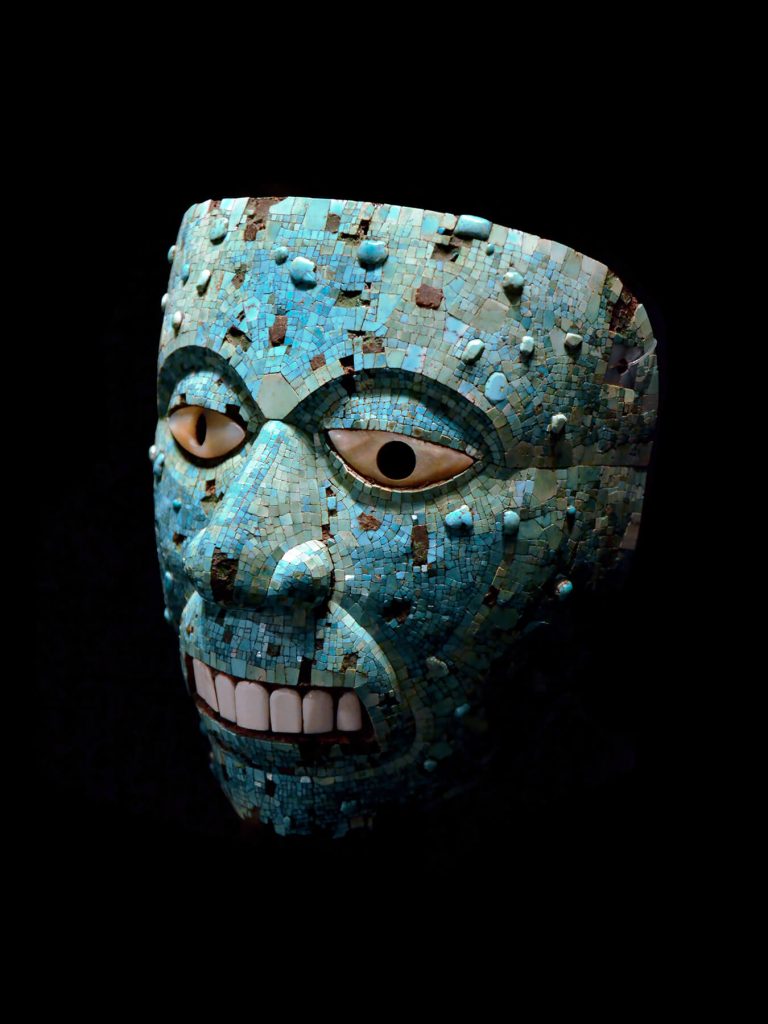
1/17 Turquoise mosaic mask of Xiuhtecuhtli, the Aztec god of fire (ca 14th to 16th century), currently in the British Museum. (Photo: commons.wikipedia.com)
The earliest discoveries of turquoise date back to 3000 BCE when elaborate turquoise jewels were found in Egyptian tombs. Tutankhamen’s burial mask was also adorned with the blue stone. The ancient Persians wore turquoise on their turbans and around their necks, adorning their daggers with it, believing that the gem offered protection. They even covered palace domes with sky blue turquoise as its colour represented heaven.

2/17 Carved 17.5-cm turquoise boulder from the Qing Dynasty in China (ca 1644-1911), which sold recently at Christie’s. (Photo: Christie’s)
Turkish traders travelling along the Silk Road introduced the Persian blue stones to Europe in the 13th century. The gem’s name is thought to come from the French “pierres turquois” signifying Turkish stones, even though the gems came from Persia.
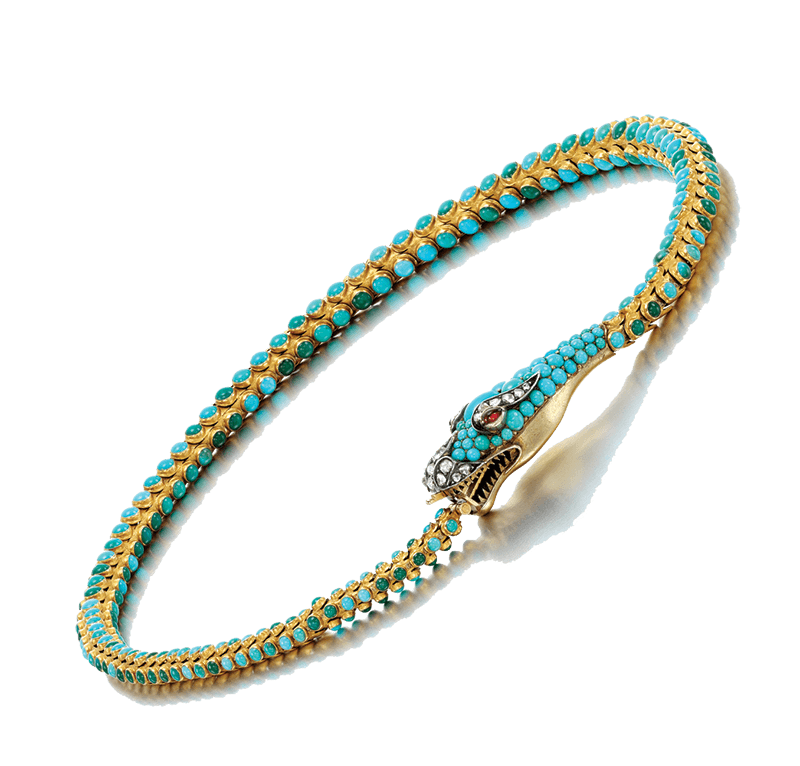
3/17 Victorian turquoise and gold serpent (ca 1840s), unsigned. (Photo: Sotheby’s)
In the meantime, pre-Columbian civilisations in the New World mined turquoise in what is now the Southwestern United States and Mexico. It was used as decoration and in ceremonies to commune with the spirit of the sky. The blue gem was later traded southward in Central and South America, where the Aztecs and Mayans valued the gem for its protective power and decorated ceremonial masks, shields and knives. For them, turquoise was more precious than gold.
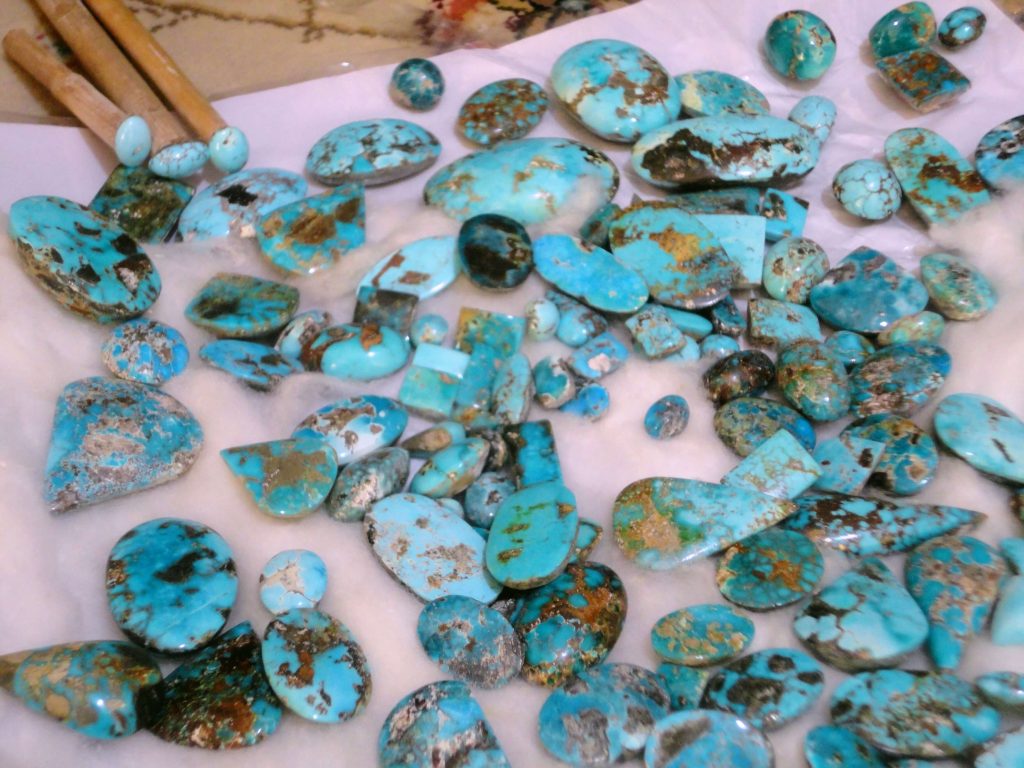
4/17 Selection of Persian turquoise from mines near Nishapur in Iran. (Photo: commons.wikipedia.com)
Traditionally, the finest turquoise came from Persia/Iran, and the robin’s egg blue stones mined near Nishapur are still considered the reference guide for evaluating turquoise quality. Today, however, most of the best quality gems come from the USA, the largest producer. It also is found in Africa, Siberia, China, Europe and Australia.
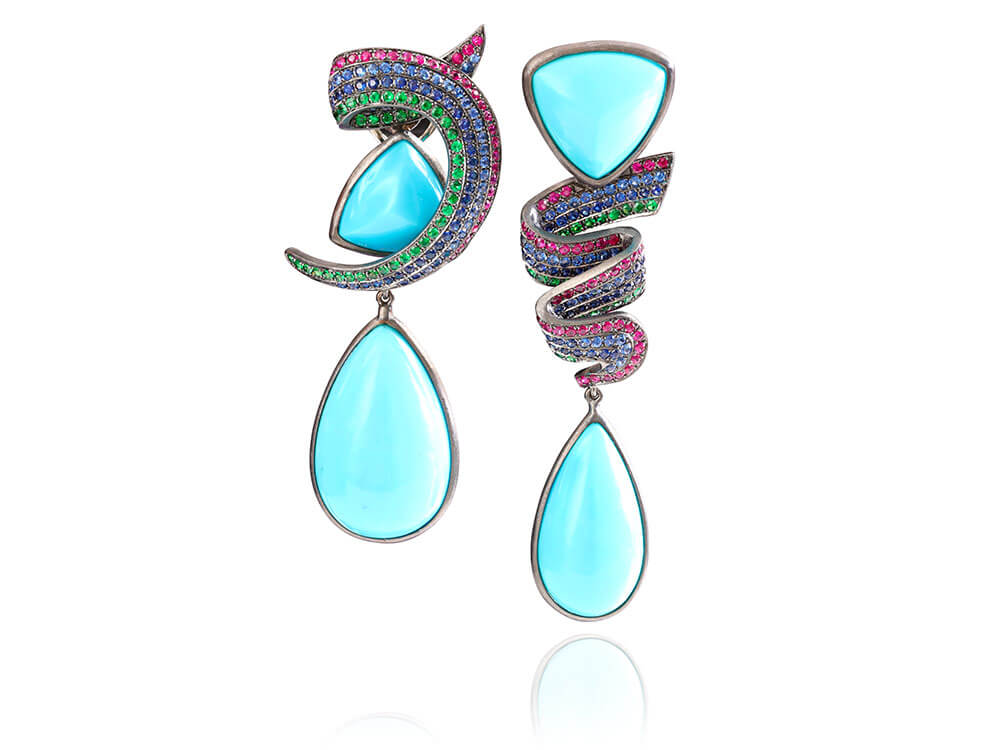
5/17 “Rainbow” earrings from Lydia Courtelle featuring turquoise, sapphire, ruby and tsavorite in 18K gold. (Photo: Lydia Courtelle)
To Treat or Not to Treat
Turquoise is a hydrated phosphate of copper and aluminium, with a hardness of 6. It is generally found in areas where there is a high concentration of copper in the soil. The blue colour is created by copper and the stone’s green tones come from bivalent iron and chrome. The stone often has veins or splotches throughout, which can be grey, brown, gold, yellow or black depending on location, and are known as the “turquoise matrix.” Turquoise is generally not faceted, but rather cut into cabochons or beads or other shapes, with the matrix adding interest and individuality to the gem.
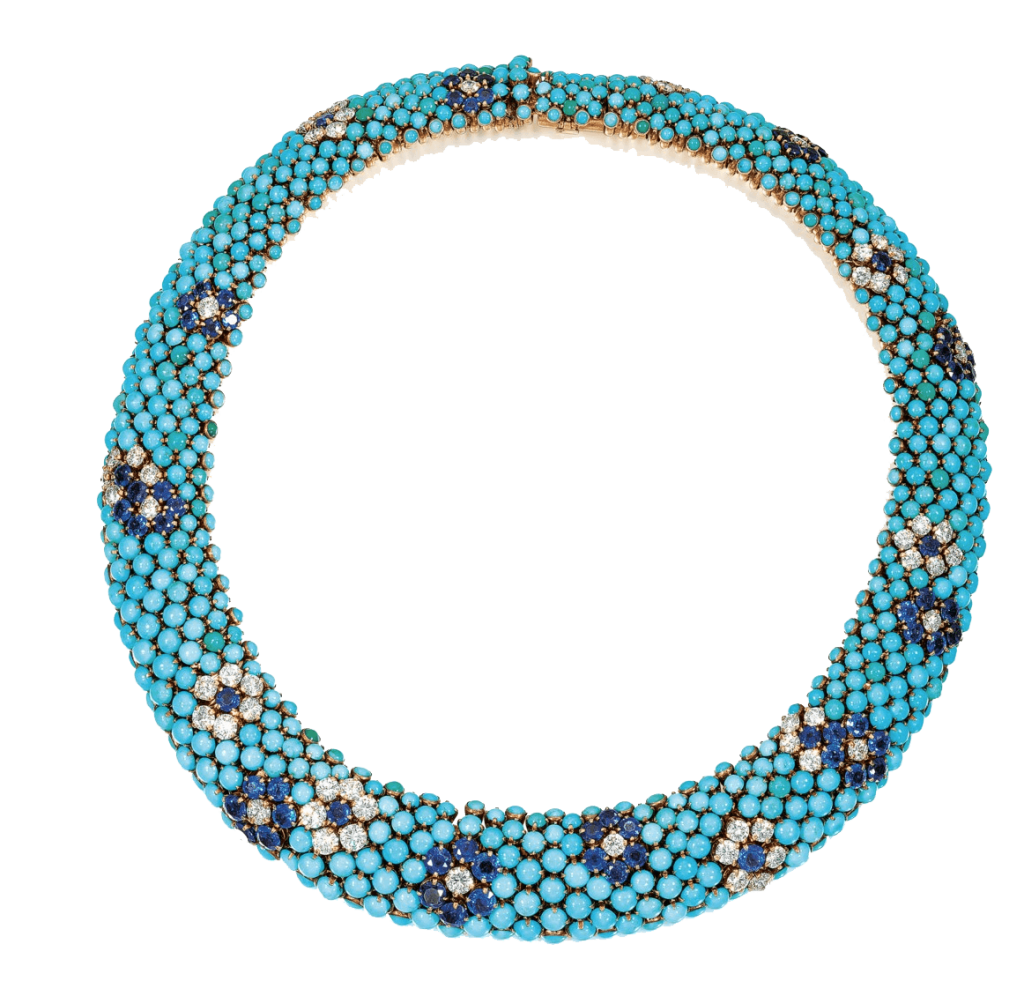
6/17 Turquoise, sapphire and diamond necklace, ca 1960s, by Van Cleef & Arpels, which sold at Christie’s. (Photo: Christie’s
Because it is a relatively soft gemstone, turquoise is often subjected to various treatments. “Natural” turquoise has not been treated, but the vast majority of stones are not hard enough to be used in jewellery and therefore must undergo some sort of acceptable treatment. Enhancement is the least intrusive as the stones are treated electrochemically to improve colour and lustre. Turquoise may also be stabilised by various techniques to harden the stone. Other treatments include oiling and waxing to bring out the colour and protect the stone, although these are not as permanent as stabilisation. Turquoise may also be dyed, which is not considered an acceptable treatment, and buyers should be told if this is the case. Buyers should also be aware that low-quality turquoise may be ground into a powder and mixed with blue dye and epoxy to simulate the gem.
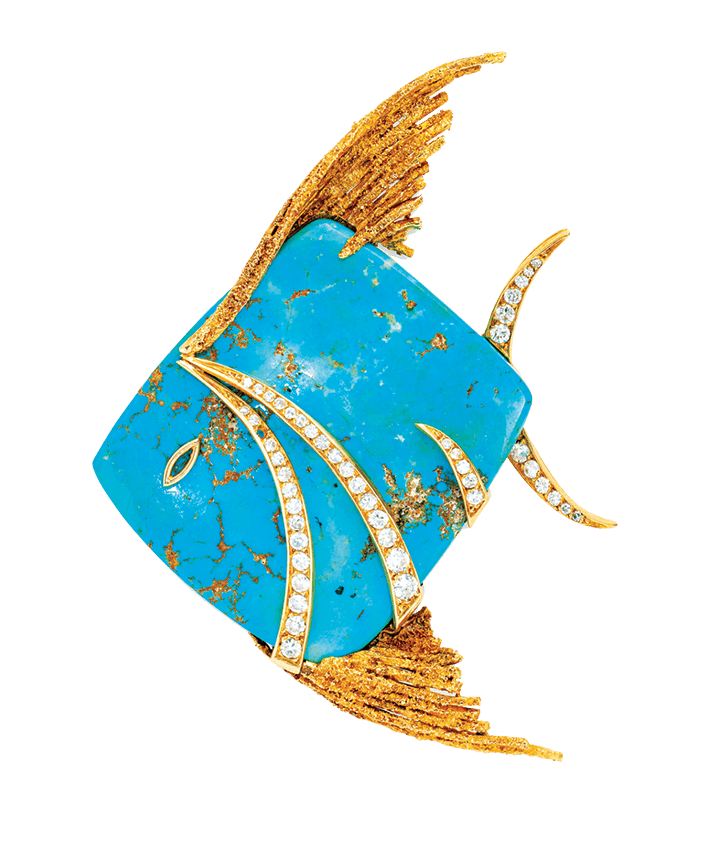
7/17 Whimsical turquoise and diamond fish in gold, ca 1960s, by Sterlé, sold by Christie’s. (Photo: Christie’s)
Universal Appeal
While turquoise has been used through the ages, it is also valued by many contemporary creators, from artists to high jewellery brands. They appreciate the gem for both its natural mottled appearance, making it as individual as the wearer, as well as for its more uniform beautiful blue tones. Parisian designer Lydia Courteille uses the stone in several original collections, while another French designer, Sterlé, creates whimsical designs with the blue gem. Still in France, Cartier, Van Cleef and other Place Vendôme brands have incorporated turquoise into their collections.
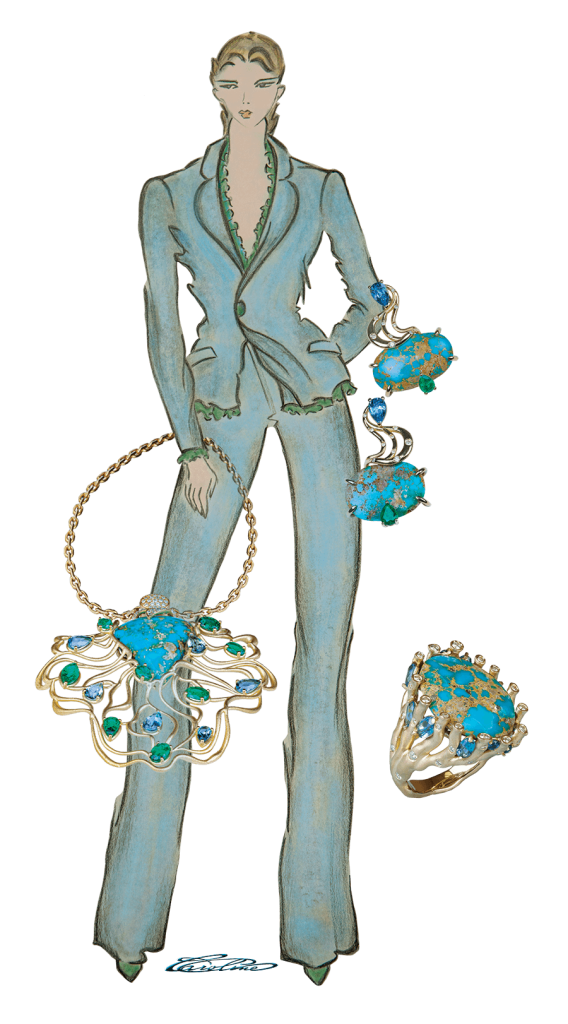
9/17 Persian turquoise necklace, rings and earrings accented with sapphire and emerald, are featured with a fashion sketch by Caroline Chartouni.
(Photo: Caroline C)
In the USA, New York jewellery (and high-fashion) designer Caroline Chartouni appreciates fine Persian turquoise for its unique colours, using it in her free-flowing organic designs, accented by other gems. Other jewellers prefer gems from the mines in the Southwestern USA, such as Arizona jewellery artist Helen Serras-Herman, who carves the gems into various forms and sets them in silver and/or gold. Retailer Susan Eisen sells silver-set turquoise pieces in her Texas store along with custom Southwest designs, as exemplified by a unique piece to adorn a western hat.
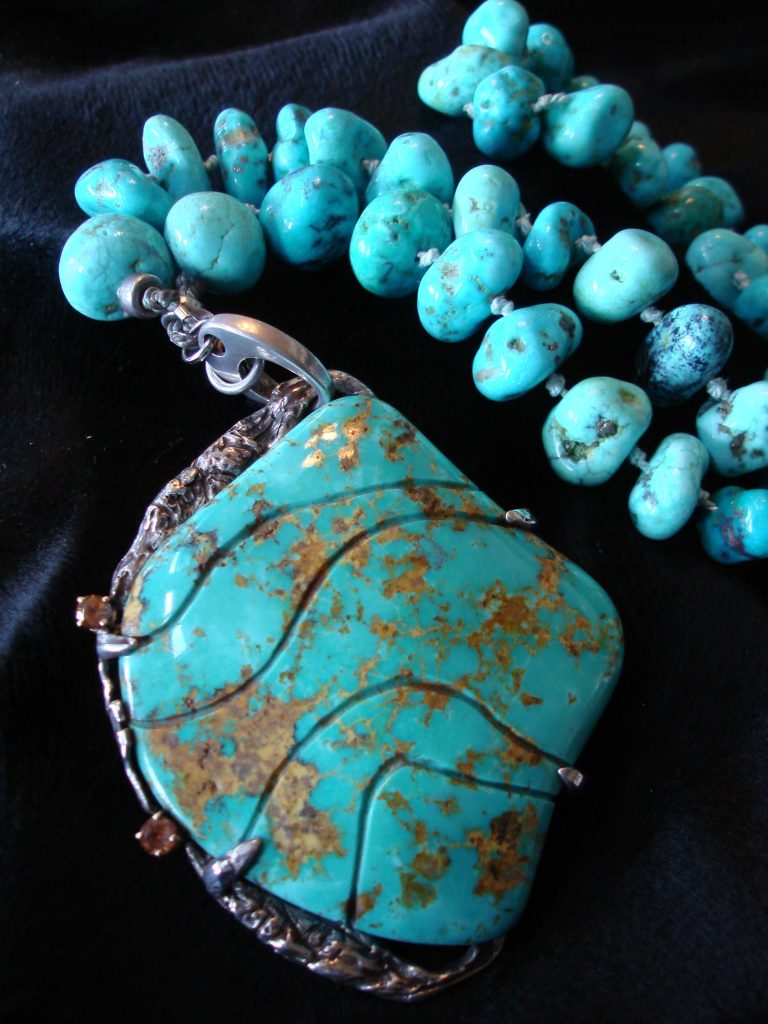
9/17 Pendant featuring a carved 260-ct natural turquoise with golden limonite inclusions from the now-closed Hachita Mine in New Mexico in gold and silver, accented with Montana sapphires by Helen Serras- Herman. (Photo: Gem Art Center)
Since the 1880s, silver and turquoise have long been associated with Native American jewellery, among them Zuni and Apache brooches, pins, earrings, beads and necklaces, as well as Navajo belt buckles and bracelets, among jewels from other tribes. While some of the mines in the Southwest (Arizona, Nevada, New Mexico and Colorado) have been depleted, others are still supplying fine quality turquoise to a network of artisanal creators in the USA as well as aficionados and designers around the world.
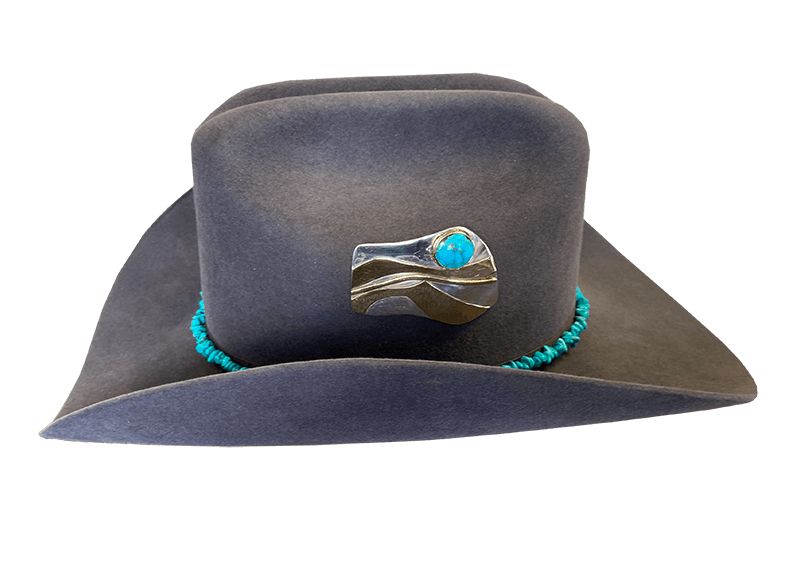
10/17 A custom-made brooch/hat decoration in turquoise, gold and silver with turquoise beads by Susan Eisen. (Photo: Susan Eisen Fine Jewelry)
Australian Turquoise
Turquoise is quite rare in Australia. Although there are some limited occurrences around the country, they do not produce high quantities or qualities. The blue gem was discovered in the 1970s during surveys for copper mining near Broken Hill in New South Wales, where gems were extracted until 1996, but with few quality specimens.

11/17 Sample of rough turquoise from the Bisbee mine (Arizona) and a polished Bisbee cabochon set in silver by Dwight and Christy Schannep.(Photo: Dwight and Christy Schannep)
The Tosca Mine near the Amaroo pastoral station homestead in Northern Territory was also examined in detail in the early 1970s, with several pits bulldozed to expose the layer of turquoise. Carving and specimen grade material were found but only minor traces of gem grade turquoise. The area is covered by an Aboriginal sacred site order, which may have limited commercial mining and exploration.
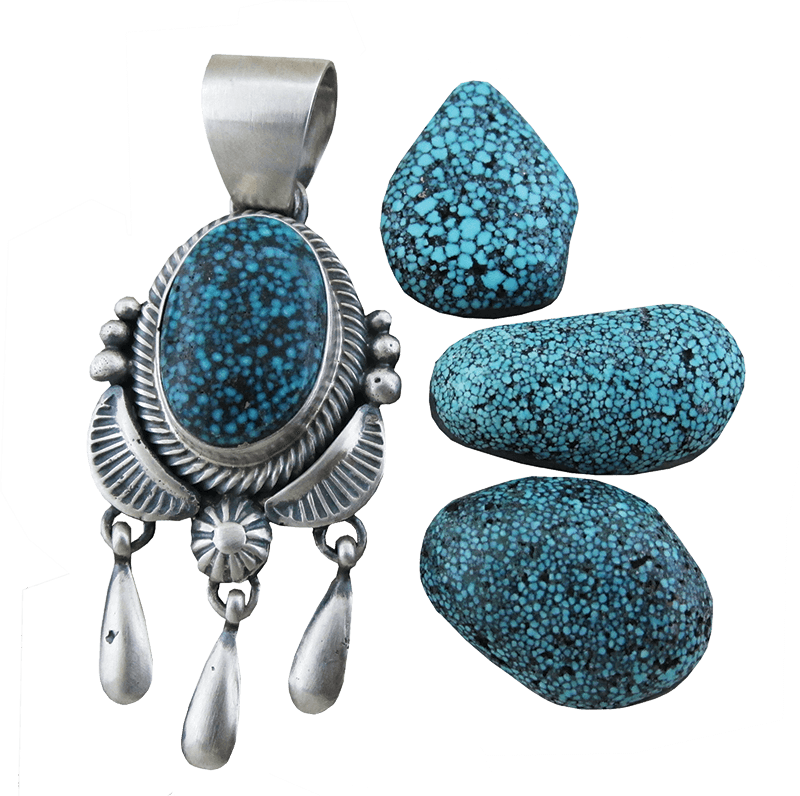
12/17 Samples of loose Spider Web turquoise from the Kingman mines (Arizona) and set in a silver pendant by Dwight and Christy Schannep. (Photo: Dwight and Christy Schannep)
Last year, Scott and Kimberly Smith, a husband-and-wife mining team, realised the potential of the Tosca Mine and purchased it. “We renamed it the Amaroo Mine,” states Kimberly. “Today, it is the only commercial turquoise mining operation in Australia.” She notes that their buyers are not only from Australia but from around the world, including Arizona, which has its own excellent turquoise production.
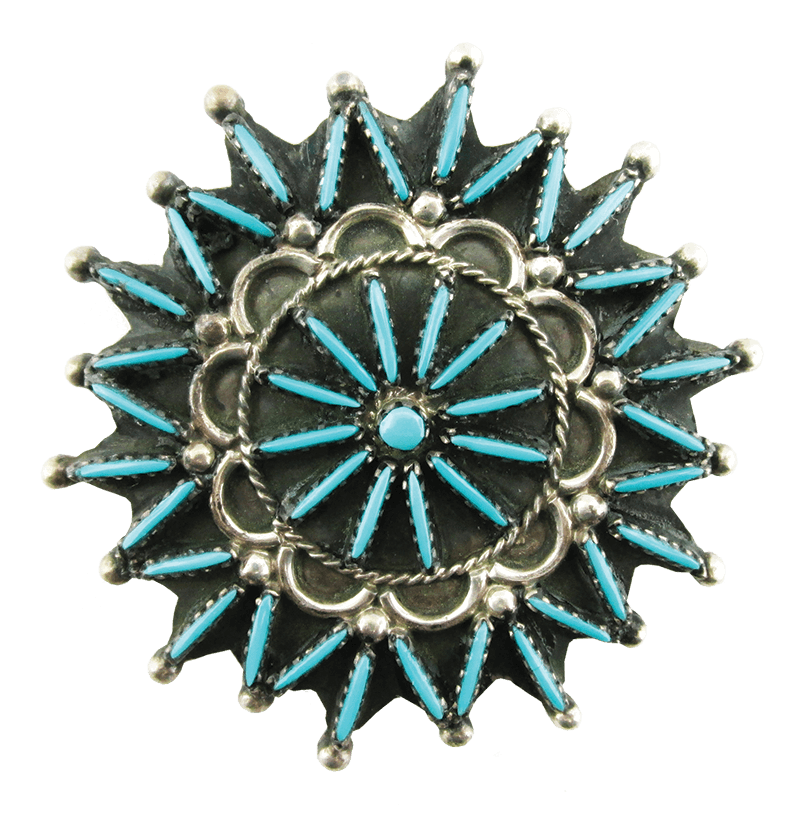
13/17 Zuni needlepoint pin in silver, unsigned. (Photo: Dwight and Christy Schannep)
Scott, who is also a lapidary expert and cuts many of the stones himself, goes on to explain that “the turquoise layers are found within claystone, overlying a conglomerate bed. The turquoise bed is half an inch to six inches thick. Trace malachite and chrysocolla have been found with the turquoise.”
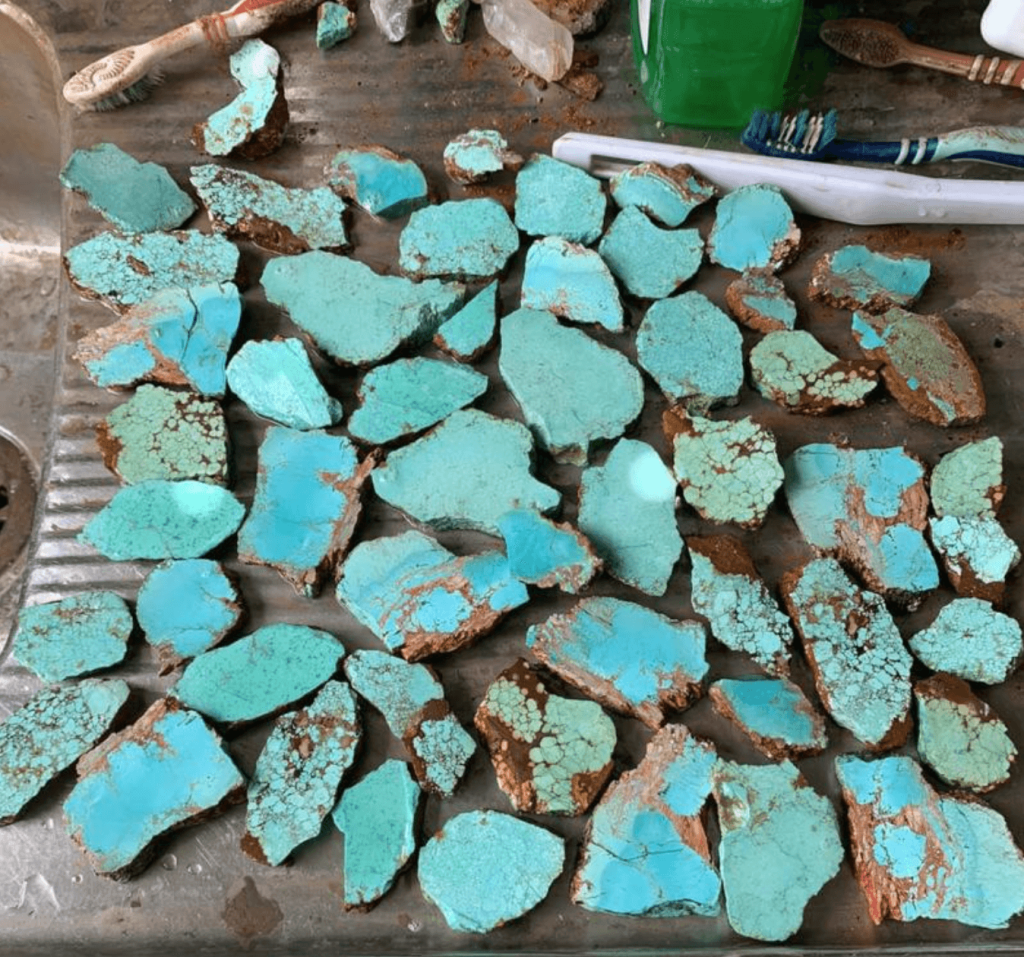
14/17 Natural slabs of Australian turquoise ready for cabbing, mined by Scott and Kimberly Smith at the Amaroo Mine in the Northern Territory. (Photo: Scott Smith)
With its many colours and patterns, turquoise from around the world is indeed a beautiful and intriguing birthstone for the month of December.
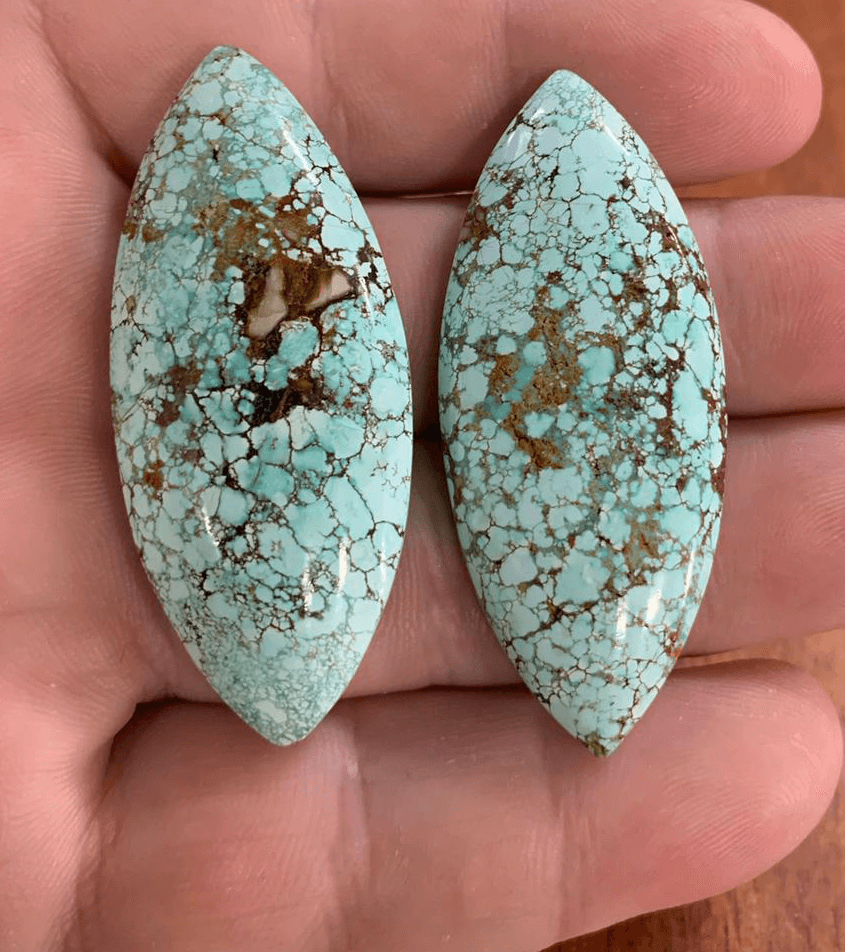
15/17 A pair of natural Australian turquoise (95 cts each) exhibiting a webbed pattern, cabbed by Scott Smith. (Photo: Scott Smith)
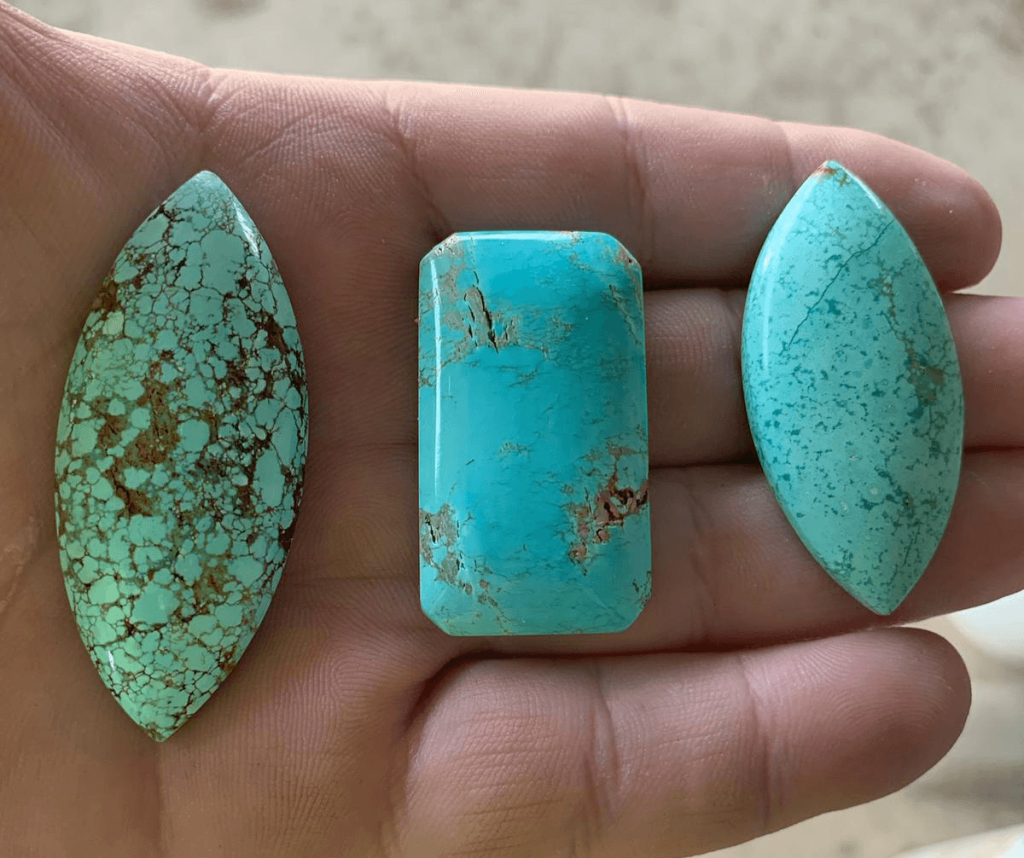
16/17 Left to right: Amaroo webbed turquoise, sky blue turquoise, and blue with green spots, an unusual combination as all three were mined in the same area, cabbed by Scott Smith. (Photo: Scott Smith)

17/17 A high-end chunk of turquoise from Amaroo station mined in 2019. (Photo: Scott Smith
Read below for related stories: